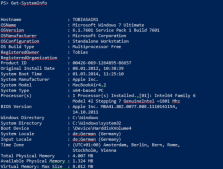数组的元素可以使用索引寻址,第一个元素的索引为0,第i个元素的索引为i-1,最后一个元素的索引为Count-1,但是Powershell为了使用方便,直接可以将 -1 作为最后的一个元素的索引。
|
1
2
3
4
5
6
7
8
9
|
PS C:Powershell> $books="元素1","元素2","元素3"PS C:Powershell> $books[0]元素1PS C:Powershell> $books[1]元素2PS C:Powershell> $books[($book.Count-1)]元素3PS C:Powershell> $books[-1]元素3 |
从数组中选择多个元素
|
1
2
3
4
5
6
7
8
9
10
|
PS C:Powershell> $result=lsPS C:Powershell> $result[0,3,5,12] Directory: C:PowershellMode LastWriteTime Length Name---- ------------- ------ ----d---- 2011/11/23 17:25 ABC-a--- 2011/11/24 20:04 26384 a.txt-a--- 2011/11/24 20:27 12060 alias.ps1-a--- 2011/11/24 17:37 7420 name.html |
将数组逆序输出
|
1
2
3
4
5
|
PS C:Powershell> $books="元素1","元素2","元素3"PS C:Powershell> $books[($books.Count)..0]元素3元素2元素1 |
给数组添加和删除元素
因为Powershell数组在内存中是顺序存储的,所以数组的大小必须是确定的,这样才方便分配存储空间,所以给数组增加元素其实相当于创建一个新的数组,只不过之后会把原来的副本删除。在当前数组追加元素可以使用“+=”操作符。
|
1
2
3
4
5
6
7
|
PS C:Powershell> $books="元素1","元素2","元素3"PS C:Powershell> $books+="元素4"PS C:Powershell> $books元素1元素2元素3元素4 |
要删除第三个元素可是使用:
|
1
2
3
4
5
6
7
8
9
10
11
|
PS C:Powershell> $num=1..4PS C:Powershell> $num1234PS C:Powershell> $num=$num[0..1]+$num[3]PS C:Powershell> $num124 |







